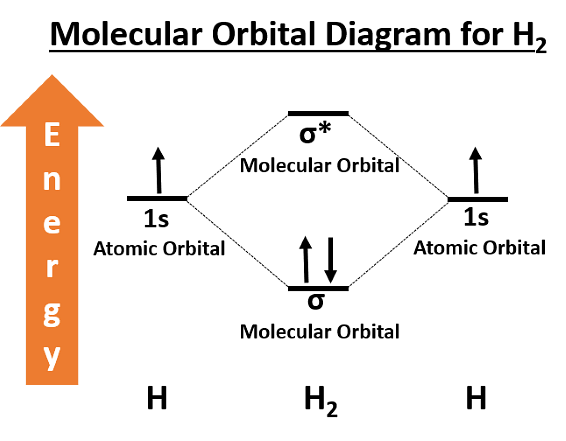Identify the correct increasing order of energies of molecular orbitals for F2 molecule.
Identify the correct increasing order of energies of molecular orbitals for F2 molecule.
\(σ_{1s}< σ^{*}_{1s} < σ_{2s} < σ^{*}_{2s}\)
\(σ_{1s}< σ_{2s} <σ^{*}_{1s} < σ^{*}_{2s}\)
\(σ_{1s} < σ^{*}_{1s} < σ^{*}_{2s} < σ_{2s}\)
\(σ ^{*}_{1s} < σ_{1s} < σ^{ *}_{2s} < σ_{2s}\)
The Correct Option is D
Solution and Explanation
Let's break down the options to understand why this is the correct order:
- In the F2 molecule, the \(σ_{1s}\) bonding orbital is formed by the overlap of the two 1s atomic orbitals from each fluorine atom. This bonding orbital is lower in energy compared to the other molecular orbitals.
- The \(σ^{*}_{1s}\) antibonding orbital is formed by the destructive overlap of the two 1s atomic orbitals. It is higher in energy than the \(σ_{1s}\) bonding orbital.
- The \(σ_{2s}\) bonding orbital is formed by the overlap of the two 2s atomic orbitals from each fluorine atom. It is lower in energy than the σ* 1s orbital.
- Finally, the \(σ^{*}_{2s}\) antibonding orbital is formed by the destructive overlap of the two 2s atomic orbitals. It is higher in energy than the \(σ_{2s}\) bonding orbital.
Therefore, the correct order is \(σ^{*}_{1s} < σ_{1s} < σ^{*}_{2s} < σ_{2s}\), which corresponds to option (D).
Top Questions on Chemical bonding and molecular structure
- Observe the following statements
Statement-I: Hybridisation is not same in both SF₆ and BrF₅.
Statement-II: BrF₅ is Square pyramidal while SF₆ is octahedral in shape
The correct answer is- TS EAMCET - 2025
- Chemistry
- Chemical bonding and molecular structure
- The sum of bond order of \(O_2\), \(O_2^-\), \(O_2^{2-}\) and \(O_2^+\) is equal to
- TS EAMCET - 2025
- Chemistry
- Chemical bonding and molecular structure
Identify the correct orders against the property mentioned:
A. H$_2$O $>$ NH$_3$ $>$ CHCl$_3$ - dipole moment
B. XeF$_4$ $>$ XeO$_3$ $>$ XeF$_2$ - number of lone pairs on central atom
C. O–H $>$ C–H $>$ N–O - bond length
D. N$_2$>O$_2$>H$_2$ - bond enthalpy
Choose the correct answer from the options given below:- NEET (UG) - 2025
- Chemistry
- Chemical bonding and molecular structure
- Given below are two statements:
Statement I: A hypothetical diatomic molecule with bond order zero is quite stable.
Statement II: As bond order increases, the bond length increases.
In the light of the above statements, choose the most appropriate answer from the options given below:- NEET (UG) - 2025
- Chemistry
- Chemical bonding and molecular structure
- Name the type of bond in the formation of chlorine molecule.
- Maharashtra Class X Board - 2025
- Science & Technology
- Chemical bonding and molecular structure
Questions Asked in MHT CET exam
- Evaluate the integral: \[ \int \frac{1}{\sin^2 2x \cdot \cos^2 2x} \, dx \]
- MHT CET - 2025
- Trigonometric Identities
- Evaluate the integral: ∫ log((2 + x)2 + x) dx
- MHT CET - 2025
- physical world
- The magnetic moment of \( \text{Mn}^{3+} \) is:
- MHT CET - 2025
- d -and f -Block Elements
- For a first-order reaction, the slope of the graph between \(\log[A]\) vs time is equal to:
- MHT CET - 2025
- Order of Reaction
- What is the correct order of thermal stability of the following carbonates?
BaCO\(_3\), MgCO\(_3\), SrCO\(_3\), CaCO\(_3\)- MHT CET - 2025
- The s-Block Elements
Concepts Used:
Molecular Orbital Theory
The Molecular Orbital Theory is a more sophisticated model of chemical bonding where new molecular orbitals are generated using a mathematical process called Linear Combination of Atomic Orbitals (LCAO).
Molecular Orbital theory is a chemical bonding theory that states that individual atoms combine together to form molecular orbitals. Due to this arrangement in MOT Theory, electrons associated with different nuclei can be found in different atomic orbitals. In molecular orbital theory, the electrons present in a molecule are not assigned to individual chemical bonds between the atoms. Rather, they are treated as moving under the influence of the atomic nuclei in the entire molecule.
